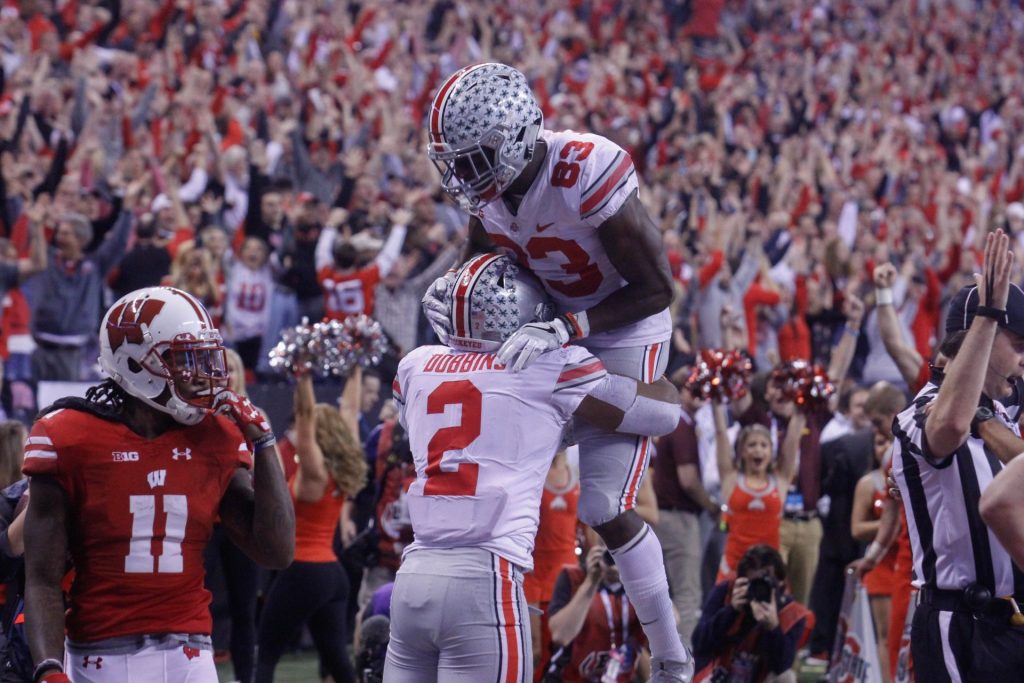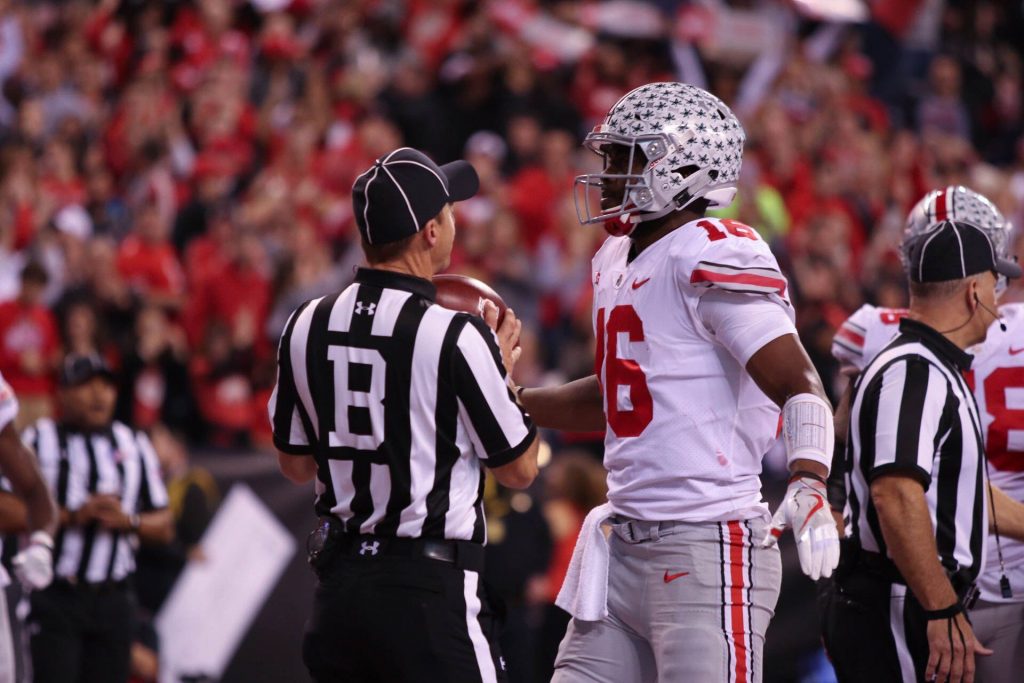
Ohio State freshman running back J.K. Dobbins (2) and junior wide receiver Terry McLaurin (83) celebrate a large run in the first quarter of the B1G Championship game against Wisconsin on Dec. 2 in Lucas Oil Stadium. Ohio State won 27-21. Credit: James King II | Sports Director
INDIANAPOLIS — Ohio State claimed its first Big Ten title since 2014 with a 27-21 victory against Wisconsin. The Buckeyes outgained the Badgers 449-298, and did not trail for any point during the matchup. There were plenty of statistics that tell the story of how this game finished.
18 – Wisconsin points off turnovers. The Badgers did not look great on offense. As previously stated, they had just 298 total yards, and their quarterback, Alex Hornibrook, threw two interceptions without a touchdown pass. But sometimes the best offense is a good defense. And Wisconsin’s defense essentially drove its offense Saturday. It tied the game in the first quarter on a pick-6 of Ohio State quarterback J.T. Barrett, forced and recovered a fumble on Ohio State’s 8-yard line that led to a field goal and turned an interception in the third quarter at its own 48-yard line into eight points on a touchdown that drive in the beginning of the fourth quarter.

Ohio State junior cornerback Denzel Ward (12) takes down a Badger in the third quarter of the B1G Championship game against Wisconsin on Dec. 2 in Lucas Oil Stadium. Ohio State won 27-21. Credit: Jack Westerheide | Photo Editor
Only once did Wisconsin start inside its own 40-yard line and march down the field to get points. The Badgers began at their own 23-yard line and marched down to the Ohio State 27-yard line and kicked a 46-yard field goal. Offensively, Wisconsin looked lost. But mistakes by Ohio State’s offense kept the game close throughout the matchup.
2.7 – Yards per carry by Jonathan Taylor. Heading into the game against Ohio State, Taylor was one of the leading rushers in the nation and had more rushing yards than any running back in the Big Ten. Despite only being a true freshman, his name quietly emerged as a darkhorse candidate in the Heisman Trophy. But just as Ohio State did to Penn State running back Saquon Barkley and Michigan State’s L.J. Scott, Taylor was bottled up by a stout Buckeye rushing defense, averaging his fewest yards per carry on the season. His previous low was 4.2. The 41 total rushing yards also were the lowest, stooping below the previous low of 80.
Taylor and the Badger offensive line came into the game expecting to be the catalyst for the offense, but instead the defensive line of the Buckeyes bullied the Badgers’ offensive front. No rusher had more than 7 yards on a single carry, and overall the Buckeyes had five tackles for a loss. The Badgers have relied so heavily on their freshman running back all season, but against one of the top rushing defenses in the nation in Ohio State, Taylor was unable to come through for them. And given the struggles in the passing game Wisconsin has faced all season, it was hardly a surprise to see its offense struggle to get off the ground without the help from Taylor.
19 – Rushes by J.T. Barrett. A knee injury to Barrett was evidently not enough to reduce the amount of carries he received. It would have seemed like a smart move to protect Barrett as much as possible, but the redshirt senior quarterback ran read options and designed quarterback runs as often as any other game. In the end, his 19 carries were the most of any player in the game, two more than freshman running back J.K. Dobbins.

Ohio State redshirt senior quarterback J.T. Barrett (16) hands the ball back to the referee after running in a touchdown in the second quarter of the B1G Championship game against Wisconsin on Dec. 2 in Lucas Oil Stadium. Ohio State won 27-21. Credit: Jack Westerheide | Photo Editor
The decision to use Barrett as the primary ball-carrier was made all the more puzzling by the fact Dobbins turned 17 carries into 174 yards, a 10.2 average yards per carry, while Barrett only averaged 3.2 yards per carry with 60 yards. Dobbins also had two carries each that went for more than 50 yards. If there was ever a game Ohio State would seem to lean off its quarterback for all the rushing production, it would have been this game.
141 – Yards gained on two passes from Barrett. The overall numbers for Barrett in the passing game looked solid. He was 12-for-26 for 211 yards, two touchdown passes and two interceptions. He was not outstanding by any means, but he did enough to get the job done. However, his stats take a step back when his 84-yard deep ball to wide receiver Terry McLaurin and 57-yard screen pass to H-back Parris Campbell are removed. Then, Barrett was just 10-for-24 with 70 passing yards and two interceptions.
Fortunately for Ohio State and Barrett, those two passes did happen, and nothing can remove them from the stat book. But Barrett was not overly effective Saturday. He missed several wide open receivers downfield and had a couple instances where he was nearly picked off because of wildly inaccurate throws. He did not look like the same quarterback whose name was found in the conversation for the Heisman Trophy earlier this season. He did just enough to win the game, but he had many more opportunities to break the game open and failed to convert.
0 – Sacks allowed by Ohio State. After the game, center Billy Price said every time Barrett took a hit, he was always one of the first people over there to help him up and check on him. He added that he didn’t like when people hit Barrett. So the offensive line simply made it the goal to prevent any sacks on the injured Barrett. And they did. Going up against a vaunted defensive front that was sixth in the nation in total sacks (39) and eighth in sacks per game (3.25), the Ohio State offensive line stood strong and gave its quarterback plenty of protection.
The Buckeyes did an effective job protecting their quarterback as much as possible. Though Barrett was still hit several times whenever he attempted to carry the football, he had all the time he needed to stand in the pocket and complete passes, or wait for receivers to get open. Barrett did not make the most of every opportunity, but his offensive line certainly gave him a chance to have one of his best passing games of the season.


